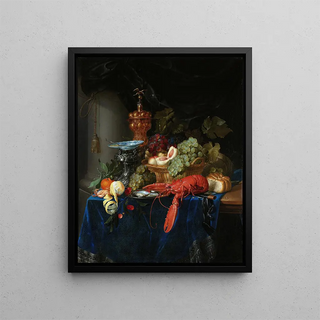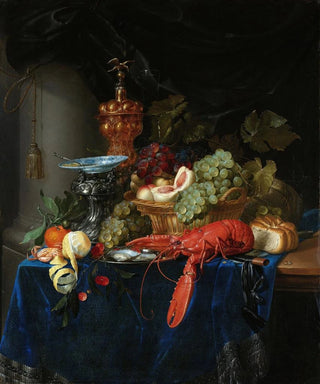Art print | Still life with a golden goblet - Pieter de Ring


View from behind

Frame (optional)
Nature morte au gobelet doré - Pieter de Ring – Captivating Introduction
The still life, a frequently underestimated artistic genre, finds a refined and poetic expression in Pieter de Ring's "Nature morte au gobelet doré." This 17th-century painting immerses us in a universe where everyday objects take on an almost sacred dimension. Through a subtle composition and unparalleled mastery of light, De Ring invites viewers to contemplate the ephemeral beauty of things. The depicted elements, though seemingly mundane, are imbued with symbolism and history, demonstrating a craftsmanship that transcends mere realism to reach emotional depth.
Style and uniqueness of the work
Pieter de Ring's style is distinguished by meticulous attention to detail and a color palette that evokes both richness and delicacy. In "Nature morte au gobelet doré," each object is carefully arranged, creating a harmonious balance that captures the eye. The gilded goblet, the centerpiece of the composition, shines with an almost supernatural glow, drawing attention while blending into the overall scene. Textures are rendered with remarkable precision, whether the smooth surface of the metal or the softness of fabrics. De Ring knows how to play with light, creating reflections that animate the objects and give them a life of their own. This artwork is not merely a representation of matter but a celebration of the intrinsic beauty of objects, an invitation to slow down and appreciate the world around us.
The artist and his influence
Pieter de Ring, active during the Dutch Golden Age, established himself as a master of the art print. His work is rooted in a tradition that values the depiction of inanimate objects while infusing it with a originality that is uniquely his own. Trained in the wake of the great masters of his time, De Ring developed a style that combines impeccable technique with artistic sensitivity. His influence extends beyond his era, inspiring many artists who sought to capture the beauty of everyday life. Through his works, he questions our relationship with objects and nature, inviting reflection on life's fleeting nature. The paintings

Matte finish

View from behind

Frame (optional)
Nature morte au gobelet doré - Pieter de Ring – Captivating Introduction
The still life, a frequently underestimated artistic genre, finds a refined and poetic expression in Pieter de Ring's "Nature morte au gobelet doré." This 17th-century painting immerses us in a universe where everyday objects take on an almost sacred dimension. Through a subtle composition and unparalleled mastery of light, De Ring invites viewers to contemplate the ephemeral beauty of things. The depicted elements, though seemingly mundane, are imbued with symbolism and history, demonstrating a craftsmanship that transcends mere realism to reach emotional depth.
Style and uniqueness of the work
Pieter de Ring's style is distinguished by meticulous attention to detail and a color palette that evokes both richness and delicacy. In "Nature morte au gobelet doré," each object is carefully arranged, creating a harmonious balance that captures the eye. The gilded goblet, the centerpiece of the composition, shines with an almost supernatural glow, drawing attention while blending into the overall scene. Textures are rendered with remarkable precision, whether the smooth surface of the metal or the softness of fabrics. De Ring knows how to play with light, creating reflections that animate the objects and give them a life of their own. This artwork is not merely a representation of matter but a celebration of the intrinsic beauty of objects, an invitation to slow down and appreciate the world around us.
The artist and his influence
Pieter de Ring, active during the Dutch Golden Age, established himself as a master of the art print. His work is rooted in a tradition that values the depiction of inanimate objects while infusing it with a originality that is uniquely his own. Trained in the wake of the great masters of his time, De Ring developed a style that combines impeccable technique with artistic sensitivity. His influence extends beyond his era, inspiring many artists who sought to capture the beauty of everyday life. Through his works, he questions our relationship with objects and nature, inviting reflection on life's fleeting nature. The paintings






